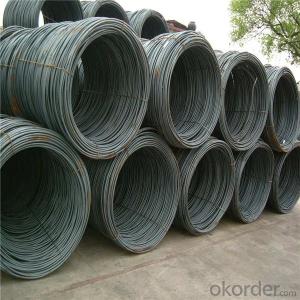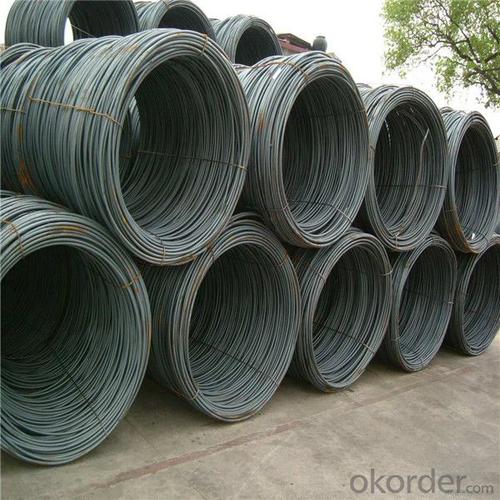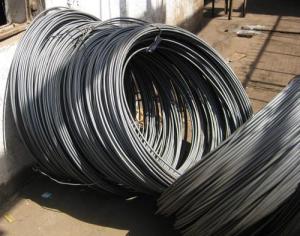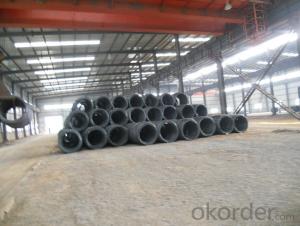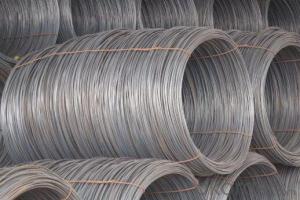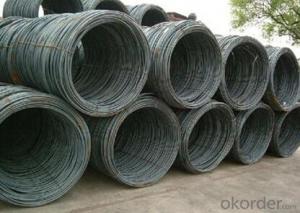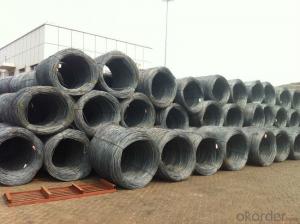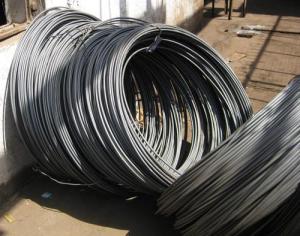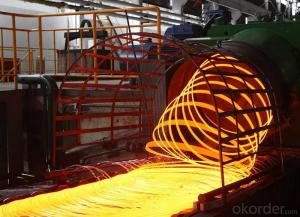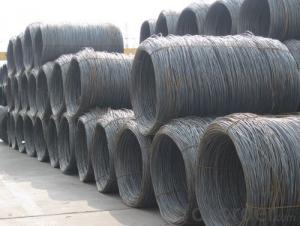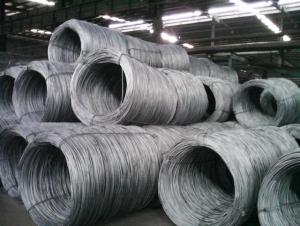Steel Wire Rod SAE1008 in different diameter
- Loading Port:
- Shanghai
- Payment Terms:
- TT OR LC
- Min Order Qty:
- 50 m.t.
- Supply Capability:
- 15621 m.t./month
OKorder Service Pledge
OKorder Financial Service
You Might Also Like
Specification
Produced from billets at the rolling mill, wire rod is the basis of all steel wire, rope and fencing products.
The most important characteristic in determining wire rod’s end use is its drawability. Common low carbon
wire rod is used for nails, small shaped products, barbed wires, various wire nettings, steel chains, and
other applications. High Carbon wire rod uses include steel tire cords for automobiles, conveyor belts, and
pressure hoses. Other applications include bolts, nuts, and machine parts, as well as compression, tension
and torsion springs
Mainly used in building and construction as binding wire, tie wire and baling wire; also can be make for wire mesh.
Our Advantage: High quality steel products from 1 class mills in
Reasonable price
Professionalism of the products
On-time delivery
Complete documents and certificates
Sincere service to meet our clients' requirements
Product Description :
Standard | AISI, ASTM, BS, DIN, GB, JIS |
Material/steel grade | Q195-Q235,SAE1006B,SAE1006CR, SAE1008B, SAE1008CR, SAE1010B, SAE1018B, or according to customers requirements |
Wire Gauge | 5.5-12mm |
Coil weight | 1.8-2.1mts |
MOQ | 25MT |
Delivery Time | 15-30 days after receipt of L/C or deposit by T/T |
Packing | In coil and load in container, if large quantity, by bulk vessel; Can be packed as customers' special requirements |
Payment terms | 1).100% irrevocable L/C at sight. 2).30% T/T prepaid and the balance against the copy of B/L. 3).30% T/T prepaid and the balance against L/C |
Application | widely used in machinery parts, manufacturing industry, electronics industry, metal tools and others |
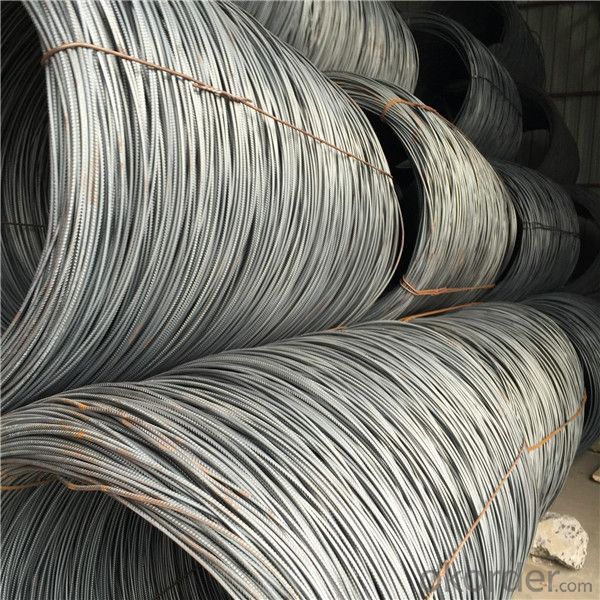
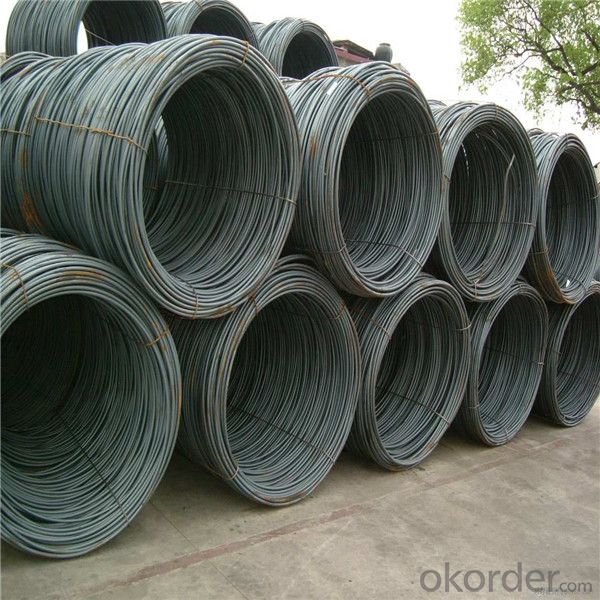
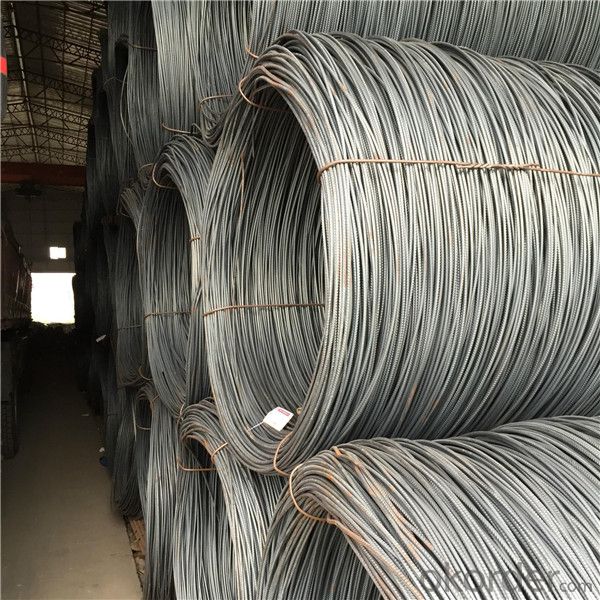
Application :
It generally used in braiding the hose for bathing product and machinery. With it
good flexibility, resistant to high temperature and resistant to corrosion, it
used widely in many industries.
Packing :
Hot-rolled wire rod is held in a unit with at least four steel straps in the
transverse direction and transported and stored without further packaging.
Before
the steel strapping is applied, the wire rod must be sufficiently compressed.
The strapping is fixed in the transverse direction with a single circumferential
strap so that the strapping does not slip and cause the coil to come apart.
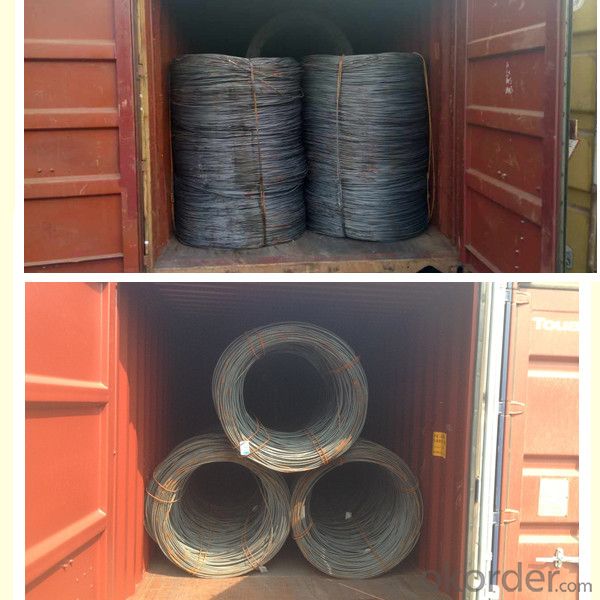
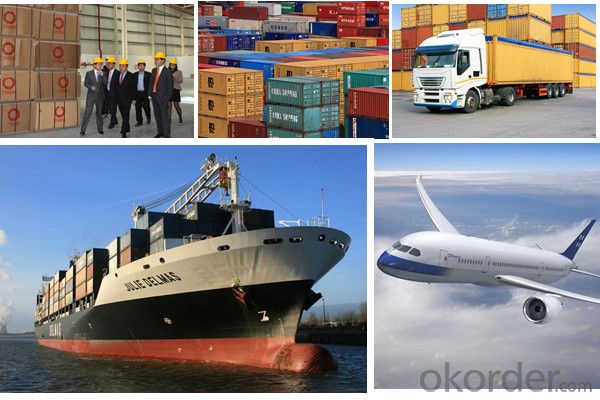
Our service:
(1) We cooperate with famous factories with advanced equipment and well trained workers.
(2) We can provide factory price with trading company service.
(3) We continuously work on the improvement of our processes, guaranteeing
consistently high standards of quality to keep none compensation.
(4) We guarantee 24 hours response and 48 hours solution providing service.
(5) We accept small order quantity before formal cooperation.
(6) We deliver the agreed quality at the agreed time, reacting to changes in
customer wishes in a flexible way.
(7) Due to our volume and selling power, we have excellent freight rates with
shipping lines.
(8) We strive to always be fair and honest in our dealings with customers.
(9) We strive to work together with customers to achieve much more than we can
achieve alone.
(10) Through our passion and commitment we aim to be a market leader in all our
key markets. To maintain our position as market leader we must continue to add
value in all that we do.
FAQ:
1.Q: What's your MOQ(minimum order quantity)?
A: One full container, mixed acceptable .
2. Q: What's your packing methods?
A: Packed in bundle or bulk ..
3. Q: How can I buy CNBM products in my country?
A:Please send us an inquiry or email ,we will reply to you if there is distributor in your country
4. Q: Can we visit your factory?
A: Warmly welcome. Once we have your schedule, we will arrange the
professional sales team to follow up your case.
5. Q: How long does it take to get the product if i place an order?
A:With the process of your requirements,we will pack and deliver in 3
-7 days. If it is by sea shipment,it will take 15-45 days depending on different locations
- Q: What are the common handling methods for steel wire rod?
- Some common handling methods for steel wire rod include using cranes or forklifts to lift and transport the rods, using racks or pallets to store and organize them, and using slings or hooks to secure and move them within a facility. Additionally, proper packaging and labeling are important for safe handling and identification of the wire rods.
- Q: How is steel wire rod used in the manufacturing of staples?
- Steel wire rod is commonly used in the manufacturing of staples due to its strength and durability. It is first drawn into the desired diameter and then cut into appropriate lengths for staple production. The wire rod is then shaped into U-shaped or flat formations, creating the basic structure of the staple. These staples are then further processed, including processes like galvanizing or coating, to enhance their corrosion resistance. Overall, steel wire rod serves as a fundamental material in staple manufacturing, providing the necessary strength and structure for these widely used fasteners.
- Q: How is steel wire rod used in the manufacturing of automotive seat frames?
- Steel wire rod is commonly used in the manufacturing of automotive seat frames due to its high strength and durability properties. The steel wire rod is typically formed into different shapes and sizes to create the framework for automotive seats. These seat frames provide structural support and stability to the seats, ensuring they can withstand the weight and movements of passengers. The steel wire rod is first processed through various manufacturing techniques such as hot rolling, cold drawing, and heat treatment to achieve the desired mechanical properties. This process ensures that the steel wire rod has the necessary strength and flexibility to withstand the constant stress and load-bearing requirements of automotive seat frames. Once the steel wire rod is prepared, it is then bent and shaped into the required form using specialized machinery. This allows manufacturers to create different seat frame designs that meet the specific requirements of different vehicle models. The steel wire rod is often welded or joined together at specific points to form a sturdy and stable seat frame structure. The use of steel wire rod in automotive seat frames offers several advantages. Firstly, steel is known for its high strength-to-weight ratio, making it an ideal material for supporting heavy loads without adding excessive weight to the vehicle. Additionally, steel wire rod has excellent corrosion resistance properties, ensuring that seat frames remain durable and long-lasting even in harsh environmental conditions. Moreover, steel wire rod provides flexibility in design and customization. Manufacturers can easily modify the shape and size of the seat frames to accommodate various seat configurations and ergonomic requirements. This allows for the production of comfortable and safe seating options for passengers. In summary, steel wire rod is essential in the manufacturing of automotive seat frames due to its strength, durability, and customization capabilities. It provides the necessary structural support and stability to ensure the safety and comfort of vehicle occupants.
- Q: How does steel wire rod compare to other materials, such as aluminum or copper?
- Steel wire rod is comparably stronger and more durable than materials such as aluminum or copper. Steel has a higher tensile strength, making it better suited for applications that require high strength and resistance to bending or stretching. Additionally, steel wire rod is generally more cost-effective and widely available compared to aluminum or copper, making it a preferred choice in various industries including construction, automotive, and manufacturing.
- Q: What are the main factors influencing the choice of steel wire rod order packaging marking options?
- The main factors influencing the choice of steel wire rod order packaging marking options include compliance with industry standards, customer requirements, and logistical considerations. Firstly, compliance with industry standards is a critical factor in choosing the packaging marking options for steel wire rod orders. Different industries may have specific requirements for the type and placement of markings on packaging materials. These standards ensure that the product can be easily identified, tracked, and handled throughout the supply chain. Compliance with these standards is essential for smooth operations and to meet regulatory requirements. Secondly, customer requirements play a significant role in determining the packaging marking options. Customers may have specific labeling or marking requirements that need to be followed. These requirements can vary based on the destination of the product, customer preferences, and any specific branding or identification needs. Meeting customer requirements is crucial for customer satisfaction and maintaining strong business relationships. Lastly, logistical considerations also influence the choice of packaging marking options. The way the steel wire rod orders are handled during transportation, storage, and loading/unloading can impact the choice of packaging markings. For example, if the orders are frequently stacked or stored in specific orientations, the markings need to be placed accordingly to ensure easy identification and handling. Additionally, considering the size, shape, and material of the packaging itself is important to determine the most suitable marking options. Overall, the main factors influencing the choice of steel wire rod order packaging marking options are industry standards, customer requirements, and logistical considerations. By carefully considering these factors, businesses can ensure efficient and effective packaging marking solutions that meet the needs of all stakeholders involved.
- Q: How are steel wire rods used in the production of barbed fences?
- Due to their strength and durability, steel wire rods play a crucial role in the manufacturing of barbed fences. These wire rods serve as the fundamental material for producing the barbed wire used for constructing these fences. The process begins by passing the steel wire rods through a series of dies, which reduces their diameter and increases their length. This wire drawing process ensures that the wire rods have a consistent thickness and strength. Once the desired thickness is achieved, the wire rods are twisted together to form a sturdy and resilient wire strand. This wire strand is then modified by adding sharp and pointed barbs at regular intervals. Typically, the barbs are created by cutting the wire strand and bending the cut ends outward, resulting in a hook-like structure. This design effectively deters trespassers and animals from crossing the fence. The resulting barbed wire is then wound onto rolls, making it easy to unroll and attach to fence posts or other support structures during installation. The sharp barbs on the wire act as a deterrent, making it challenging for intruders or livestock to pass through the fence without getting caught or injured. In conclusion, steel wire rods are essential for producing barbed fences due to their strength, durability, and flexibility. The addition of barbs to the wire strand further enhances the security provided by these fences, making them widely used in various applications, including agricultural fencing, military installations, and perimeter security.
- Q: What are the major steel wire rod trade shows and conferences?
- Some major steel wire rod trade shows and conferences include Wire Düsseldorf, Wire Southeast Asia, and Wire China. These events provide a platform for industry professionals to showcase their products, network, and stay updated on the latest trends and technologies in the steel wire rod sector.
- Q: How is steel wire rod used in the manufacturing of wire for elevator door systems?
- The manufacturing of wire for elevator door systems heavily relies on steel wire rod. For elevator doors to function properly, they need wires that are strong, durable, and capable of enduring constant use and frequent opening and closing. Steel wire rod, derived from steel billets and serving as a semi-finished product, is the primary raw material utilized in wire production. To initiate the process, steel wire rod goes through various mechanical and heat treatments to enhance its strength and flexibility. These treatments, such as hot rolling, drawing, and annealing, refine the wire's structure and enhance its mechanical properties. The objective is to ensure that the resulting wire can withstand the tensions and stresses encountered during elevator door operations. Once the wire rod has undergone processing, it is further drawn and shaped to meet the desired dimensions and specifications for elevator door systems. This involves passing the wire through a series of dies, gradually reducing its diameter and shaping it into the required form. The wire is then cut to the desired length and undergoes additional treatments, such as heat treatment or coating, to further enhance its properties and protect against corrosion. The manufactured wire is subsequently utilized in various components of elevator door systems. It is commonly employed as tension cables or counterweight cables, providing the necessary strength and support for smooth door operation. These wires are meticulously installed, routed, and connected to the elevator mechanism to ensure safe and reliable functionality. In conclusion, steel wire rod is a crucial element in the production of wire for elevator door systems. Through various treatments and processes, it acquires enhanced strength and flexibility, resulting in high-quality wire capable of meeting the demanding requirements of elevator door operations. This wire is then utilized in tension cables and counterweight cables to provide the necessary strength and support for elevator door systems.
- Q: How is steel wire rod used in the manufacturing of reinforcement bars?
- Steel wire rod is used in the manufacturing of reinforcement bars by being transformed into a continuous coil through a series of processes such as hot rolling, cooling, and surface treatment. This coil is then further processed to obtain the desired diameter and shape of reinforcement bars, which are widely used in construction projects to enhance the tensile strength and durability of concrete structures.
- Q: How is steel wire rod used in the manufacturing of wire racks?
- Steel wire rod is a crucial component in the manufacturing of wire racks as it serves as the primary material used to create the framework and structure of the rack. The wire rod is initially processed through a series of steps such as heating, rolling, and drawing to transform it into a thin, long, and continuous wire. This wire is then bent, shaped, and welded to form the different parts of the wire rack, including the sides, shelves, and supports. The high tensile strength and durability of steel wire rod make it an ideal choice for wire racks as it can bear heavy loads and withstand constant use without bending or breaking. Additionally, the steel wire rod's corrosion resistance properties ensure that the wire racks remain sturdy and long-lasting, even in environments with high humidity or exposure to moisture. The versatility of steel wire rod allows manufacturers to create wire racks in various sizes and designs to cater to different storage needs. The wire rod can be easily manipulated to form different shapes, allowing for the creation of wire racks with adjustable shelves or collapsible features. This flexibility in design makes wire racks highly customizable and adaptable for use in various settings, such as homes, offices, warehouses, or retail stores. Furthermore, the use of steel wire rod in wire rack manufacturing enables efficient production processes. The wire rod can be easily cut, shaped, and welded using automated machinery, reducing production time and costs. This ease of manufacturing also allows for mass production of wire racks, ensuring a steady supply to meet market demands. In conclusion, steel wire rod plays a vital role in the manufacturing of wire racks by providing the necessary strength, durability, and versatility required for these storage solutions. Its ability to be easily shaped, resistance to corrosion, and cost-effectiveness make it an ideal material for creating wire racks of various sizes and designs.
Send your message to us
Steel Wire Rod SAE1008 in different diameter
- Loading Port:
- Shanghai
- Payment Terms:
- TT OR LC
- Min Order Qty:
- 50 m.t.
- Supply Capability:
- 15621 m.t./month
OKorder Service Pledge
OKorder Financial Service
Similar products
Hot products
Hot Searches
Related keywords
